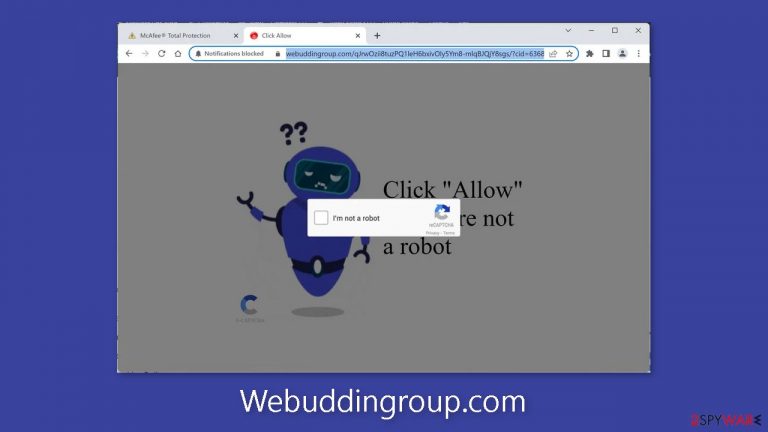Webuddingroup.com ads (spam) - Free Guide
Webuddingroup.com ads Removal Guide
What is Webuddingroup.com ads?
Webuddingroup.com tries to trick people into allowing pop-up spam with social engineering

Webuddingroup.com is a fraudulent website that employs social engineering[1] techniques to trick users into subscribing to push notifications. Crooks try to persuade people that they must click the “Allow” button to prove that they are not robots. Instead, they begin to receive annoying pop-up ads.
Unless a page has been flagged as malicious, your browser should never block access to it. Be wary of fake captcha verification pages or any sites that ask you to click “Allow” on a browser prompt that allows you to send show push notifications.
Furthermore, fraudsters may use rogue advertising networks to place ads that lead to dangerous websites. People may unknowingly end up on scam pages that attempt to obtain personal information or force them to download PUPs (potentially unwanted programs)[2] and malware.
| NAME | Webuddingroup.com |
| TYPE | Push notification spam; adware |
| SYMPTOMS | Pop-up ads, and banners start appearing on the screen even when the browser is closed |
| DISTRIBUTION | Shady websites; deceptive ads; freeware installations |
| DANGERS | Deceptive advertisements can lead to dangerous websites where users are at risk of giving away their personal information and suffering from monetary losses or downloading malicious software |
| ELIMINATION | Remove website permissions via browser settings or deploy professional security software to detect adware |
| FURTHER STEPS | Use FortectIntego for remediation and fix any damage left |
Distribution methods
Sites that send push notifications, such as Webuddingroup.com, are rarely found in search results. Most of the time, they hide in other shady, unregulated locations. Pages that engage in illegal activities are riddled with deceptive ads and sneaky redirects that can lead to fraudulent websites.
We recommend that you only visit websites that you are familiar with and trust. Use legitimate streaming services, such as Netflix or Hulu, instead of illegal streaming sites,[3] which frequently display bogus “Download” and “Play” buttons that redirect users to deceptive pages.
Do not click on random links and advertisements. Even if the advertisement appears to promote legitimate and well-known products, it is best to go directly to the source. Another possibility is that the page appeared without any input from the user. This can happen if you have adware on your computer. It may result in an increase in commercial content such as pop-ups, banners, and redirects.

Stop the pop-ups
Webuddingroup.com begins to display advertisements for bogus browser extensions, security tools, and so on. Push notifications operate on a subscription basis, so you must block them yourself. You can easily accomplish this by following our step-by-step instructions:
Google Chrome (desktop):
- Open Google Chrome browser and go to Menu > Settings.
- Scroll down and click on Advanced.
- Locate the Privacy and security section and pick Site Settings > Notifications.

- Look at the Allow section and look for a suspicious URL.
- Click the three vertical dots next to it and pick Block. This should remove unwanted notifications from Google Chrome.

Google Chrome (Android):
- Open Google Chrome and tap on Settings (three vertical dots).
- Select Notifications.
- Scroll down to Sites section.
- Locate the unwanted URL and toggle the button to the left (Off setting).

Mozilla Firefox:
- Open Mozilla Firefox and go to Menu > Options.
- Click on Privacy & Security section.
- Under Permissions, you should be able to see Notifications. Click Settings button next to it.

- In the Settings – Notification Permissions window, click on the drop-down menu by the URL in question.
- Select Block and then click on Save Changes. This should remove unwanted notifications from Mozilla Firefox.

Safari:
- Click on Safari > Preferences…
- Go to Websites tab and, under General, select Notifications.
- Select the web address in question, click the drop-down menu and select Deny.

MS Edge:
- Open Microsoft Edge, and click the Settings and more button (three horizontal dots) at the top-right of the window.
- Select Settings and then go to Advanced.
- Under Website permissions, pick Manage permissions and select the URL in question.
- Toggle the switch to the left to turn notifications off on Microsoft Edge.

MS Edge (Chromium):
- Open Microsoft Edge, and go to Settings.
- Select Site permissions.
- Go to Notifications on the right.
- Under Allow, you will find the unwanted entry.
- Click on More actions and select Block.

Clear your browsers
Cookies are small text files that can track your browsing activity and store information such as your IP address, geolocation, websites visited, links clicked on, and items purchased. This information is normally used to personalize the user experience, but crooks use it to make money. They are lucrative to ad networks and other third parties.
They can even be hijacked and used for malicious purposes, which is why security experts recommend that they be cleared on a regular basis. A maintenance tool like FortectIntego can make this process much easier. Furthermore, this powerful software can repair a variety of system errors, corrupted files, and registry issues, which is especially useful following a virus infection.
Check your system for adware infection
If blocking site permissions in your browser settings did not work, you may have a potentially unwanted program on your system that is generating ads in the background without your permission. Adware is a type of program that infiltrates the system through freeware distribution platforms.
If you are unsure that your system is completely safe and you are still experiencing unwanted symptoms, you should scan your system with anti-malware tools such as SpyHunter 5Combo Cleaner or Malwarebytes or other trusted ones. Security software can also help you avoid future infections by alerting you to suspicious programs. If you want to give it a shot, here are the instructions for Windows and macOS:
Windows 10/8 machines:
- Enter Control Panel into Windows search box and hit Enter or click on the search result.
- Under Programs, select Uninstall a program.

- From the list, find the entry of the suspicious program.
- Right-click on the application and select Uninstall.
- If User Account Control shows up, click Yes.
- Wait till uninstallation process is complete and click OK.

Windows 7/XP:
- Click on Windows Start > Control Panel located on the right pane (if you are Windows XP user, click on Add/Remove Programs).
- In Control Panel, select Programs > Uninstall a program.

- Pick the unwanted application by clicking on it once.
- At the top, click Uninstall/Change.
- In the confirmation prompt, pick Yes.
- Click OK once the removal process is finished.
macOS:
- From the menu bar, select Go > Applications.
- In the Applications folder, look for all related entries.
- Click on the app and drag it to Trash (or right-click and pick Move to Trash)

To fully remove an unwanted app, you need to access Application Support, LaunchAgents, and LaunchDaemons folders and delete relevant files:
- Select Go > Go to Folder.
- Enter /Library/Application Support and click Go or press Enter.
- In the Application Support folder, look for any dubious entries and then delete them.
- Now enter /Library/LaunchAgents and /Library/LaunchDaemons folders the same way and terminate all the related .plist files.

d
How to prevent from getting adware
Do not let government spy on you
The government has many issues in regards to tracking users' data and spying on citizens, so you should take this into consideration and learn more about shady information gathering practices. Avoid any unwanted government tracking or spying by going totally anonymous on the internet.
You can choose a different location when you go online and access any material you want without particular content restrictions. You can easily enjoy internet connection without any risks of being hacked by using Private Internet Access VPN.
Control the information that can be accessed by government any other unwanted party and surf online without being spied on. Even if you are not involved in illegal activities or trust your selection of services, platforms, be suspicious for your own security and take precautionary measures by using the VPN service.
Backup files for the later use, in case of the malware attack
Computer users can suffer from data losses due to cyber infections or their own faulty doings. Ransomware can encrypt and hold files hostage, while unforeseen power cuts might cause a loss of important documents. If you have proper up-to-date backups, you can easily recover after such an incident and get back to work. It is also equally important to update backups on a regular basis so that the newest information remains intact – you can set this process to be performed automatically.
When you have the previous version of every important document or project you can avoid frustration and breakdowns. It comes in handy when malware strikes out of nowhere. Use Data Recovery Pro for the data restoration process.
- ^ What is Social Engineering?. Webroot. Cybersecurity Tips.
- ^ Wendy Zamora. What is a PUP? – How to avoid potentially unwanted programs. Malwarebytes. Tips, Tricks, and How-Tos.
- ^ Brittni Devlin. Why Should You Avoid Illegal Streaming Sites?. Makeuseof. Security Blog.
